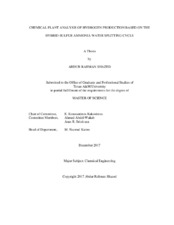| dc.description.abstract | Several types of research are going on for the development of the green hydrogen generation process. One similar effort to produce green hydrogen is the current work. Hydrogen is useful for both mobile and stationary fuel cell purposes. The current solar thermochemical water splitting cycle (TCWSC) can reach an overall efficiency of 35-40%. This efficiency is higher than that of other solar-to-hydrogen generation processes, i.e., PV-electrolysis, photo-electrochemical, photo-catalytic and photo-biological.However, there are some shortcomings that demote feasibility of the current TCWSC for practical application. These shortcomings are (i) the utilization of only the thermal (IR) component of the solar irradiation, neglecting a photonic (UV-Vis) component; (ii) not taking into consideration the intermittent nature of the solar resource; and (iii) the involvement of technically challenging reagents transport and separation stages. The objectives of this current work are to develop a solar water splitting production process that can utilize both the thermal and photonic parts of the solar energy and integrate a thermal energy storage system, which can supply the thermal energy in the absence of sun.
The developed process consists mainly five reactors (a photochemical, three thermochemical & an absorber). This process also has incorporated a thermal energy storage system. This thermal energy storage system utilizes process fluid (molten salts and gasses) to store or supply energy. The process is a total recycle process, as only water is fed to the system for getting hydrogen and oxygen as products and all other materials are contained in the system. The plant was designed to produce 7000 kmol H2/hr that is equivalent to 476 MW energy based on a lower heating value of
hydrogen. The required thermodynamic properties for some species involved in the model were obtained from the literature, as these compounds' properties are not available in the database of Aspen properties. Moreover, an improved thermodynamic model from literature was used in the simulator to enhance the performance of the developed model. An optimum solar-to-H2 efficiency of 50% was achieved, which is higher than previous attempts (~23%). At the same time, to ensure complete liquid operation of the cycle, literature data of the K2SO4-K2S2O7 phase diagram was incorporated into the model.
The simulation showed for that 1 hour, the thermal energy storage system could keep the temperature of all the reactors at the desired level even without the presence of the sun. This TES absorbs and stores thermal energy from the process while there is more energy than required and supplies energy when there is energy shortage in the process. However, in the absence of the sun, the model will not produce any hydrogen, as there will be no photonic energy at that time, which reduces the efficiency to zero.
The maximum salt flow rate for supplying thermal energy was found to be 330 kmol/kmol of hydrogen and for storing energy was 2139 kmol/kmol of hydrogen. Moreover, the economic analysis indicated that both options, i.e., process with thermal energy storage system and process without thermal energy storage system are economically feasible. The internal rate of returns for the two options are 20.57% and 24.44% consecutively for this two options. The analysis also showed that though the process with TES is not economically feasible, it enables early start-up of the production process and provides production stability. | en |


